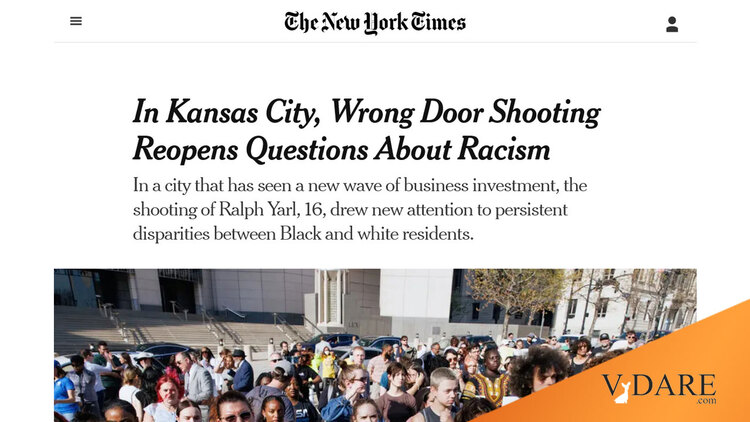From the New York Times news section, here’s the 20th article of the past week about the wounding by a white man of a Black child, Upper-Case American Ralph Yarl.
In Kansas City, Wrong Door Shooting Reopens Questions About Racism
In a city that has seen a new wave of business investment, the shooting of Ralph Yarl, 16, drew new attention to persistent disparities between Black and white residents.
By Mitch Smith
April 23, 2023KANSAS CITY, Mo.—From one vantage point, a post-pandemic boom seemed to be taking hold in Kansas City. …
But the shooting of a Black teenager named Ralph Yarl this month by an older white man on the city’s northern edge jolted residents and shifted the civic conversation. By the time prosecutors filed felony charges last week against the accused gunman, Andrew D. Lester, 84, Kansas City found itself uncomfortably in the national spotlight, and residents were asking how a teen could be shot for something as trivial as ringing the wrong doorbell, and why it took four days to bring charges.
For many, the case reopened big questions about racism and segregation that have been fused into the city’s history for generations but never fully reckoned with.
You will be absolutely astonished to learn that the Conversation is about how this man-bites-Dog, white-shoots-Black police-blotter item requires that blacks be given huge amounts of money:
“We need to clean up our house so that we can be proud and not performative when we have company,” said Gwen Grant, the president and chief executive of the Urban League of Greater Kansas City. She said her city needed to “address the root causes of these problems, and address the systems, and not run away from the tough race and racism conversations.” …
In the earliest days of Kansas City’s history, Black people were brought to Missouri as enslaved people, and a pattern of entrenched segregation has shaped the city ever since.
… In the first day or two after the shooting, it received little notice in Kansas City, where gun violence is a daily reality and the homicide rate is consistently one of the country’s worst among large cities. It was not until April 15, two days after the shooting, that Mayor Lucas said he heard about the case after being tagged in the comments of an Instagram post by The Kansas City Defender, a local media outlet that grew out of the 2020 national protest movement and focuses on Black Kansas Citians. …
Fifty-six percent of Kansas City residents are white, 27 percent are Black, 11 percent are Hispanic and 3 percent are Asian. But police data shows that 75 percent of homicide victims this year have been Black. There have been more homicides so far in 2023 than during the same period in 2022, which local media outlets have described as the second-deadliest year in city history.
In the 26th paragraph, you finally get some Dog-bites-man statistics to provide a bit of perspective, but no effort is made to make their import clear:
Fifty-six percent of Kansas City residents are white, 27 percent are Black, 11 percent are Hispanic and 3 percent are Asian. But police data shows that 75 percent of homicide victims this year have been Black. There have been more homicides so far in 2023 than during the same period in 2022, which local media outlets have described as the second-deadliest year in city history.
Instead, I’ll look up the FBI UCR homicide stats for 2021 recorded by the Kansas City Police Department. As usual, FBI stats are useless at distinguishing Hispanics from non-Hispanic whites, so I’ll just look at two groups: blacks and nonblacks.
| Known Homicide Offenders | Share | % of Population | Black to Non Black Ratio | |
| Total Known | 138 | 100% | ||
| Black | 113 | 82% | 27% | 12.2 |
| Non Black | 25 | 18% | 73% |
So, that’s a pretty standard 12 to one black to non-black ratio of homicide perps. That might be lower than in other cities with big league franchises, such as Chicago.
But it’s still a 12 to 1 ratio. What percentage of New York Times subscribers would guess that the ratio was that high?













